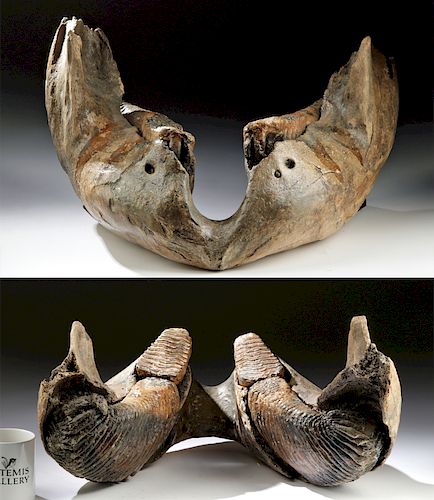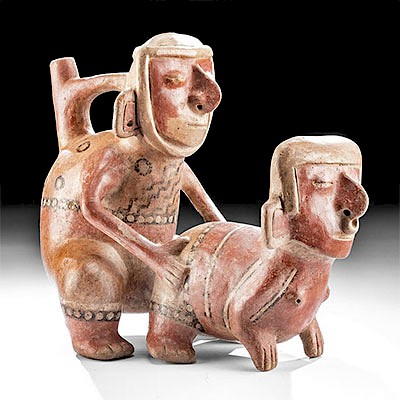Fantastic / Large Serbian Ice Age Mammoth Jawbone
Lot 3
About Seller
Artemis Fine Arts
686 S Taylor Ave, Ste 106
Louisville, CO 80027
United States
Selling antiquities, ancient and ethnographic art online since 1993, Artemis Gallery specializes in Classical Antiquities (Egyptian, Greek, Roman, Near Eastern), Asian, Pre-Columbian, African / Tribal / Oceanographic art. Our extensive inventory includes pottery, stone, metal, wood, glass and textil...Read more
Categories
Estimate:
$6,000 - $8,000
Absentee vs Live bid
Two ways to bid:
- Leave a max absentee bid and the platform will bid on your behalf up to your maximum bid during the live auction.
- Bid live during the auction and your bids will be submitted real-time to the auctioneer.
Bid Increments
| Price | Bid Increment |
|---|---|
| $0 | $25 |
| $300 | $50 |
| $1,000 | $100 |
| $2,000 | $250 |
| $5,000 | $500 |
| $10,000 | $1,000 |
| $20,000 | $2,500 |
| $50,000 | $5,000 |
| $100,000 | $10,000 |
| $200,000 | $20,000 |
About Auction
By Artemis Fine Arts
Jan 30, 2020
Set Reminder
2020-01-30 10:00:00
2020-01-30 10:00:00
America/New_York
Bidsquare
Bidsquare : Pre-Columbian | Tribal | Ethnographic
https://www.bidsquare.com/auctions/artemis-gallery/pre-columbian-tribal-ethnographic-4830
Featuring ancient and ethnographic art from around the world, including Pre-Columbian, Native American, African / Tribal, Oceanic, Ethnographic, Spanish Colonial, Fossils, Fine Art, much more. Artemis Fine Arts info@artemisgallery.com
Featuring ancient and ethnographic art from around the world, including Pre-Columbian, Native American, African / Tribal, Oceanic, Ethnographic, Spanish Colonial, Fossils, Fine Art, much more. Artemis Fine Arts info@artemisgallery.com
- Lot Description
Eastern Europe, found along the Donau River near Novi Sad, Serbia, Pleistocene epoch (Ice Age), ca. 35,000 years ago. A wonderfully preserved fossilized mammoth jawbone with both of its M2 and M3 molars for four teeth total, all showing signs of having been used for browsing the delicious (if you're a mammoth) woody vegetable matter of ancient forests. The original chemicals of the teeth have been replaced in the fossilization process with quartz (silica) and other minerals, creating a rich, deep brown color with some ocher yellow highlights. The jawbone itself is massive, with a few natural cavities that would have somewhat diminished its weight - but still, imagine the neck muscles of the creature that held this heavy jawbone up above its feet! Size: 18" L x 20" W x 10.8" H (45.7 cm x 50.8 cm x 27.4 cm)
While mammoths survived until ca. 5600 years ago on remote Alaskan islands, those animals had begun to shrink in size as the climate warmed from the end of the Ice Age ca. 10,000 years ago. This jawbone comes from deep within the Pleistocene, when the northern hemisphere was dominated by massive ice sheets drained by enormous glacial rivers and lakes. Imagine finding a jawbone like this along the banks of a river, rising from the ground - the name mammoth comes from a Siberian word used to describe the tusks found there by native people, like the Khanty of the Irtysh River basin, and traded to Europe and China. Their occasional finds of massive tusks and even preserved mammoth bodies in the permafrost - often eroding out of the sides of river banks - led to their folkloric belief that mammoths were like huge rodents, dwelling underground, dying when they accidentally surfaced. With the invention of science as a discipline, massive fossils like this one continued to capture imaginations all over the world - for example, Thomas Jefferson, who was fascinated by paleontology, is credited with introducing the use of the word mammoth as an adjective to describe something very large.
Provenance: private J.H. collection, Beaverton, Oregon, USA
All items legal to buy/sell under U.S. Statute covering cultural patrimony Code 2600, CHAPTER 14, and are guaranteed to be as described or your money back.
A Certificate of Authenticity will accompany all winning bids.
We ship worldwide and handle all shipping in-house for your convenience.
#149589Lightly repaired and restored with some minor losses from the peripheries. Great deposits on surface.Condition
- Shipping Info
-
All shipping is handled in-house for your convenience. Your invoice from Artemis Gallery will include shipping calculation instructions. If in doubt, please inquire BEFORE bidding for estimated shipping costs for individual items.
-
- Buyer's Premium



 EUR
EUR CAD
CAD AUD
AUD GBP
GBP MXN
MXN HKD
HKD CNY
CNY MYR
MYR SEK
SEK SGD
SGD CHF
CHF THB
THB















